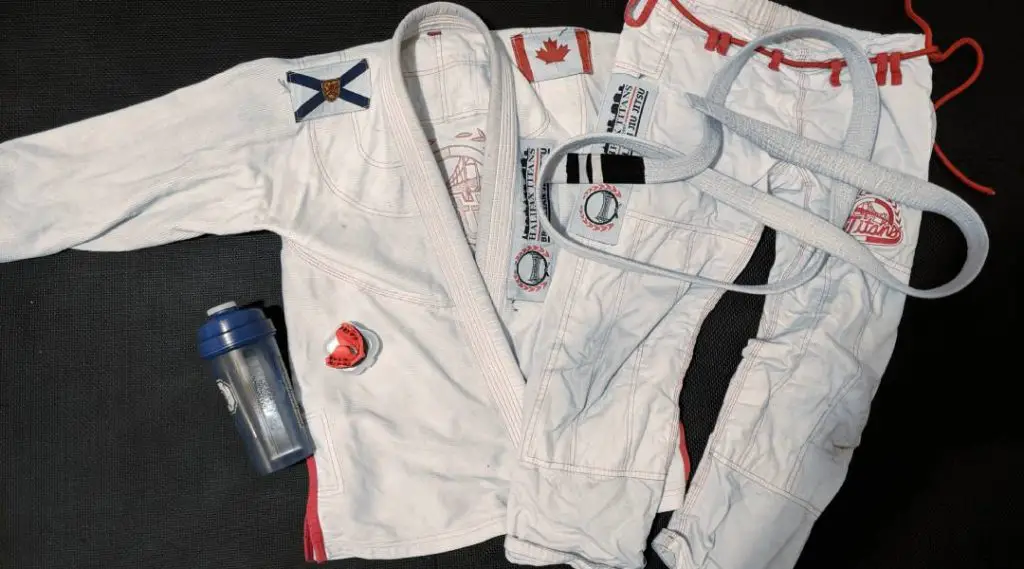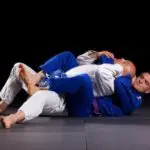You decided that it’s time to try Brazilian Jiu-Jitsu (BJJ for short). You’ve looked up a few local schools in your area and decided on one that sounds like it fits your needs. You start making your way over to the facility and all of a sudden you start second-guessing yourself. Am I ready for this? I don’t know anyone. I’m just going to embarrass myself. I don’t know anything! I don’t even know what to do!
Don’t worry. I’ve been there and countless others have too! Here is what I’ve learned over my first 6 months doing BJJ and researching what others have done as well.

10 Tips To Prepare For Your First BJJ Class
- Brush your teeth and remove jewelry/make-up
- Bring Water and Gym clothes (It’s alright if you don’t have a Gi !)
- Arrive 10-15 minutes early. Change into your gym clothes and if you have your own stretch routine – now is the time.
- When class starts it usually follows the format: Warm-up, Technique, Drill, Roll.
- Try to get with a partner of similar size and don’t be afraid to ask to work as a group of 3.
- If you need clarification it’s alright to speak up!
- If you’re not comfortably somersaulting and rolling around, ask the instructor to show you how before practicing the technique that requires it.
- You don’t have to roll your first class and if you want to roll, let your opponent know you are new.
- Don’t hammer on a submission if you already know any and if you feel like you’re getting submitted or have discomfort – tap firmly on your partner, verbally say tap tap tap, or stomp your foot.
- Most importantly: Be friendly, be humble, and don’t get frustrated! You’re not going to be good at anything your first day. Retain as much as you can and after class, it’s great to write it down.
Getting Ready For Your First Jiu-Jitsu Class
During BJJ class you’re going to be up close and personal with people in the class. So, the first thing you want to do before gathering your gym clothes and water is to remember to freshen up and remove your jewelry!
Since you are going to be getting close to others I’d highly recommend brushing your teeth – at least. Showing up to class and breathing your stale coffee breathe mixed with garlic on someone is not a good first impression!
Additionally, if you get dirty from the day or have a bit of a bad odor coming from you – consider taking a shower. Freshen up a bit, you don’t want to be remembered as the smelly person!
Do you wear jewelry? If so, make sure to remove it before class! The last thing you want is for your earring to get ripped out because it got caught on someone else’s Gi!
What To Bring To Your First Jiu-Jitsu Class
The top two things to remember to bring to your first BJJ class are gym clothes and water. Make sure your gym pants/shorts have some stretch to them as you don’t want to rip them wide open! If you can’t do a deep squat in them without them ripping, they probably won’t work in class.
Don’t worry if you do not own a Gi. Many of the other students – if it is a Gi class – will be in that traditional uniform, but since it is your first class (or even 3rd or 5th) don’t worry about it; I didn’t buy my Gi until my 6th class.
If there is a technique being taught that requires the Gi, the instructor will either show you a No-Gi variation of it, or some places have an extra Gi you can use for the class.
You won’t want to rely on the extra Gi as they can be smelly or sweaty if someone in the previous class was in the same boat you are!
Another few things that you should bring to your first BJJ class – if you have them – are mouth guard, sandals, and showering things. If you don’t have some of these on your first day, don’t worry about it! You may ask why these items?
A mouthguard is important because you will be getting tossed around sometimes or be in positions where your mouth will get bumped. The last thing you want is to chip or lose a tooth, or even bite your lip or tongue wide open!
Why sandals? First, you are not allowed to wear anything on the mats, you must have bare feet. Since that is the case, you do not want to walk around the area in bare feet – getting them all dirty – and then step on the mats with your dirty feet.
Having sandals allows you a quick way to put protection on your feet so you can walk around without leaving your socks around the gym.
Finally, feel free to bring your showering items if the gym has a shower on sight (your sandals are also great to wear in the shower to protect them from bacteria). Instead of driving home or waiting for the bus as a sweaty mess, it’s great to get freshened up before leaving!
List of items
- Gym clothes
- Water
- Mouth Guard
- Sandals
- Optional – Showering items.
What To Do When You Arrive At Your First Jiu-Jitsu Class
You should try and arrive at your BJJ class 10-15 minutes early. If you haven’t visited the gym prior to going to the first class you may need to get there earlier. This will give you extra time to first introduce yourself to the instructor, sign the waivers, get changed, and stretch.
Arriving 10-15 minutes before is very beneficial – especially on your first day to get situated. I still try to arrive early so I have time to get changed and do my own personal stretching and warm-up, as I know what my body needs to be able to function as I want it.
I’d suggest arriving a bit earlier on your first day to find the instructor so you can introduce yourself. If you had previous experience wrestling or doing another martial art let them know! It’ll give them an idea of what to expect from you. Arriving early will also give you time to introduce yourself to the other students in the class.
After you have introduced yourself to the instructor you will probably have to sign a waiver. This is your typical waiver where it is not the gym’s fault if you get injured – similar to any commercial weight lifting gym. Take a look at it, it’s always good to go through them!
Finally, arriving early gives you time to get into your gym clothes or Gi – if you already own one.
How Does A Typical Jiu-Jitsu Class Go?
A typical BJJ class goes as follows: Warm-up, Technique, Drilling, and Rolling. The warm-up is to get your body moving and used to the movements you’ll use for the rest of the class. During the technique portion of the class, the instructor will teach a skill for you to practice. After practicing a technique the students will drill, and roll (or both) with each other. This is where you will try to outmatch your teammate by getting a better position, submitting them, or not getting submitted for the time given to drill/roll.
Warm-up
The warm-up portion of the BJJ class is to get the body used to the basic movements that you’ll use for the rest for the night and to get your body ready to move. I suggest trying out some of these movements prior to going to your first class to get a better idea of how the warm-up moves look like.
Here’s a great video going through some of the movements!
Common warm-up exercises for a BJJ class are:
- Stretching
- Jogging
- Break Falls
- Foot Circles
- Bridging Variations
- Shrimping Variations
- Bear Crawls
Technique
The technique portion of the BJJ class usually takes up the most time in class and is for learning a new technique, such as a: position, submission, or takedown. The instructor will usually demonstrate the technique and then allow the students to practice it while looking at the students and giving additional information.
Most instructors will show a simple technique and then build upon it during class. For example, they may show out to get out of someone’s guard, let the students practice it, then they will get everyone to gather around and show a technique once you are out of the guard. Which looks something like this:
- The instructor demonstrates a Guard Escape technique
- Students practice the Guard Escape as the instructor walks around – instructing.
- After some time the instructor brings the student back together and shows a technique to do after you get out of someone’s guard
- Students practice getting out of guard and then the new technique once they are out of the guard.
Drilling
Drilling in BJJ is similar to live rolling, except it is rolling with intent. When you are drilling you are working on a certain aspect in BJJ, whether that is maintaining a control position, escaping a position, or looking for a certain submission. Once one of those criteria is met, you stop the live roll, reset your position to the start point and go again.
A good example of this is, if I wanted to drill side control escapes I would get my partner to go in side control. Then we would start rolling, except if I got out of side control we would stop and reset with them going back in side control. Likewise, if they advanced their position, let’s say to mount, then we would stop and reset.
Drilling is a great way to learn BJJ, as it allows both people that are drilling to practice an aspect of BJJ that they may be struggling with or wanted to sharpen up.
Drilling is also great for someone just starting as you may not know many positions or even more than what you just learned in class that day! So, just drill the technique you just learned with a bit of real resistance from your partner.
Rolling
Rolling in BJJ is like sparring in other martial arts – it is when you go against an opponent and try to outmatch them in a time frame. Whether that is holding or getting the more dominant position over them, submitting them, or simply – not getting outmatched yourself and getting out of in-superior positions.
There are multiple ways BJJ rolling can be approached, some of them are:
- Outmatching your opponent and trying to submit them.
- (Secretly) Allow your opponent to get a dominant position so you can find a way to get out of it.
- Try to get into a position where you can practice the technique that was taught in that class.
- Have a goal to get to a certain position and or try a technique in many different positions.
- Treat the rolling session as a drilling session, if your class doesn’t do drilling, by asking your partner to reset at certain positional advantages/disadvantages.
Rolling is, usually, the most fun part of the class where you can test your skills against others in your class. You’re not trying to destroy or injure anyone, you’re not there to crank on submissions or throw people around either. The key is to test your skills against your teammates and see where you are excelling and what aspects you need to focus on more.
If it’s your first class, this part of the class could be the scariest as you don’t know much – if anything – at this point! If you do not feel comfortable throwing yourself into the flames, tell the instructor and just watch how others roll. Some instructors won’t even let new students roll. If you do choose to roll, let your partner know it is your first time or that you are new to BJJ.
I recommend new students to ask their opponent to start on the ground, much like sitting on the ground, you can sit on the ground yourself. This will prevent you from getting injured from receiving a takedown that you do not know how to defend against yet. Or better yet, ask if you can start in the positions you practiced earlier in class.
What To Do If You Don’t Feel Comfortable Doing a Jiu-Jitsu Technique?
In Jiu-Jitsu there will be times when you won’t feel comfortable performing a technique – and that is okay! If you ever doubt yourself or second guess yourself be sure to ask the instructor either during or after they have demonstrated it to give you additional information. And if you are still not convinced, simply don’t do it, you know yourself most!
I’ve had some experiences where I didn’t feel comfortable performing techniques – and for different reasons! Here are a few examples:
- I didn’t feel I could safely performing a technique because I didn’t know how to make my body do what I wanted it to.
- I didn’t feel like I could perform the technique safely without, potentially, injuring my partner.
- My training partner didn’t have the experience to perform the technique.
My Body Doesn’t Know How To Perform The Jiu-Jitsu Technique
The situation was my partner and I were standing up and I had to grip their collar and their knee, then somersault from standing while dragging them to the ground. I didn’t feel comfortable doing the somersault to the ground while avoiding my partner form falling on me.
The solution: I told the instructor and my partner I didn’t feel confident in my skills to somersault from standing. So the instructor showed me an alternate version of the technique from on my knees, and once I got used to that my partner showed me a technique to get comfortable somersaulting from standing.
I Think I Might Injure My BJJ Partner
There was a time when I felt confident in my partner’s ability to perform the technique on me, but when it came time for me to do the same? Not a chance. I had a feeling I could do it but I felt like if I held onto their arm too hard to didn’t let go at the right time, I could injure them.
In this scenario, I told my partner I didn’t feel comfortable performing that part of the technique. I knew I could get close to the end result if I let go of their arm and did the body position change, even if that meant not finishing the submission portion.
Eventually, we moved onto another technique, in this case, I didn’t ask for an alternative since it was a larger class. Sometimes you may have to accept that.
My Partner Doesn’t Have The Skills To Perform The BJJ Technique
This could be you and in my scenario, I was working with a new student and the technique required him to roll over my shoulder and I needed to use that momentum to land on him. He felt confident doing the movement so we began.
BUT! The time came to roll him over my shoulder, he started going over and I felt like something was off. Before I just catapulted myself over him, I rolled to the side to see what was going on.
It turns out, he didn’t know that you must tuck your head when you roll. He was using his neck to stop himself from rolling over which means if I catapulted myself over I could have seriously damaged his neck!
This was a big lesson for me to always make sure to ask my partner if they can perform the basics of the given technique. In this case, we practiced somersaulting around before moving forward with the technique.
Learning Jiu-Jitsu Takes Time, Don’t Get Frustrated!
The main this with learning BJJ, or anything for that matter, is not to get frustrated! Just because you’re struggling with a technique while your partner seemed to have mastered it in seconds doesn’t mean you’re stupid or slow.
Some techniques will come easier to you than others and vice-versa. Also remember, not everyone learns at the same rate. It took me 4 months to learn how to do a side roll… 4 months for a simple rolling technique!
Consistency and patience go a long way. You may not learn the technique the first, second or third week, month, or year, but one day it’ll click. And guess what, one day half of it will un-click and you’ll have to relearn a portion of it again. It’s all about taking in as much as you can, even if one small detail sticks.
Conclusion
In conclusion, you should bring gym clothes and water to your first class. Don’t worry if you do not own a Gi yet. Some facilities will have one you can use for the class and the instructor will work around it. Make sure to arrive early since you will have to find the instructor and sign waivers.
When class begins you can expect a basic warm-up followed by learning a few techniques. Class with end with drilling or rolling (or both). And always remember, if you don’t feel comfortable performing technique or participating in rolling, ask the instructor for advice or simply just watch!
Always remember to enjoy yourself and treat your teammates with respect. We’re not in this to injure anyone and we can’t expect to be a master in a day or even a few years. So, enjoy the journey and stick with it! See you on the mats!


